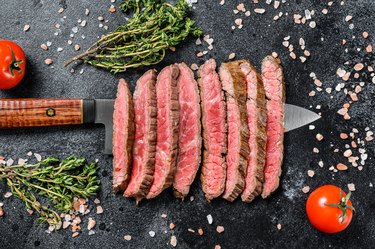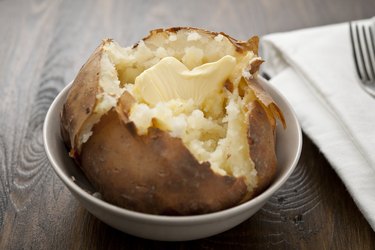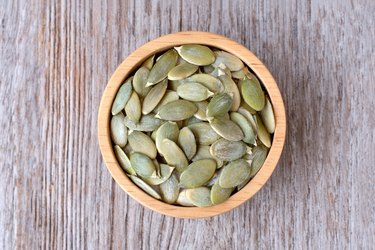It might not be the trendiest nutrient around, but niacin is undeniably essential. Also known as vitamin B3, niacin is required by hundreds of enzymes in the body to carry out key functions, like turning the proteins, fats and carbohydrates we eat into usable energy, per the National Institutes of Health (NIH).
Niacin is really the name of a group of compounds that includes molecules like nicotinic acid and nicotinamide, both of which naturally occur in the diet.
Video of the Day
Video of the Day
The main active form of niacin in the body — called nicotinamide adenine dinucleotide, or NAD — is also involved in gene expression and cell signaling.
How Much Niacin Do You Need Per Day?
The recommended dietary allowance (RDA) for the amount of niacin we need daily is measured in milligrams (mg) of niacin equivalents (NE). Niacin equivalents are applied because other nutrients, like the amino acid tryptophan, can be converted to niacin in the body, per the NIH. As such, 1 NE is equivalent to 1 mg of niacin or 60 mg of tryptophan.
The RDA for niacin differs slightly for people assigned male at birth (AMAB) and people assigned female at birth (AFAB). People AMAB ages 14 and older require 16 mg of niacin equivalents per day, while people AFAB ages 14 and older require 14 mg of niacin equivalents per day. Pregnant and lactating people require slightly more niacin per day, about 18 mg and 17 mg of niacin equivalents, respectively.
A true, severe niacin deficiency leads to a condition called pellagra, which is often defined by the four Ds: dermatitis, diarrhea, dementia and death (in extreme cases). But, niacin deficiencies are quite rare in the United States, per the NIH.
Here are 22 of the best natural sources of niacin to add to your diet today.
Note that the niacin content of the below foods does not account for any tryptophan that may be converted to NAD in the body. That's why the below niacin values are listed in milligrams instead of the milligrams of niacin equivalents we just mentioned. The daily value (DV) is based on an intake of 16 milligrams of niacin per day.
1. Yellowfin Tuna: 18.8 mg, 117% Daily Value (DV)

A cooked, 3-ounce filet of cooked yellowfin tuna delivers 117 percent of the DV for niacin, plus 83 percent of the DV for vitamin B12, which is required for energy.
2. Beef Liver: 14.7 mg, 92% DV
OK, so we don't expect you to eat beef liver on a daily basis, but the organ meat is a stellar source of B vitamins, including niacin. One slice of fried beef liver provides an impressive 92 percent of the DV for niacin. It's also rife with vitamin A, iron and zinc.
3. Turkey Breast: 10 mg, 62% DV
Turkey is often touted as the primary source of tryptophan, but in truth, many animal proteins (including eggs, chicken and cheese) provide the essential amino acid, according to the U.S. National Library of Medicine.
So, you'll probably get even more than 62 percent of the DV for niacin from this 3-ounce serving of roasted turkey breast thanks to the conversion of some of its tryptophan to NAD in the body. But in order for the amino acid to be transformed into niacin, the body must have sufficient levels of other nutrients, like iron, B6 and riboflavin.
4. Sockeye Salmon: 8.6 mg, 54% DV

In addition to providing anti-inflammatory omega-3 fatty acids and vitamin D, cooked salmon is also an excellent source of niacin, with 54 percent of the DV present in a 3-ounce serving.
5. Chicken Breast: 8 mg, 50% DV
Three ounces of cooked chicken breast can serve up 50 percent of the DV for niacin, plus 27 grams of satiating protein.
If you're feeling uninspired by poultry, try cooking up these healthy chicken recipes you haven't tried yet (we promise they won't disappoint).
6. Portobello Mushrooms: 7.6, 47% DV
For a niacin-rich meal, throw portobello mushrooms on the grill along with your protein of choice. One cup of grilled portobello mushrooms provides 47 percent of the DV for niacin, deeming them some of the best vegetarian foods high in niacin.
7. Pork Chops: 6.8 mg, 42% DV

Though fattier than other cuts like the tenderloin (which is the leanest cut of pork), chops are a great natural source of niacin. A 3-ounce, cooked pork chop delivers 42 percent of the DV for niacin.
8. Brown Rice: 5.2 mg, 32% DV
It's safe to say that brown rice is among the vegetarian foods highest in niacin. You'll get 33 percent of the DV for vitamin B3 in 1 cup of cooked brown rice. You'll also get nearly 6 grams of protein and 3 grams of fiber from the whole grain.
Tip
Pair plant-based protein sources like brown rice with black beans for a complete protein that provides all nine of the essential amino acids.
9. Canned White Tuna: 4.9 mg, 31% DV
The American Heart Association recommends eating fish at least two times per week to maintain a healthy heart. Just be sure to practice moderation when it comes to canned tuna varieties like albacore or white tuna.
Though rich in niacin — 3 ounces of canned white tuna provides 31 percent of the DV for the B vitamin — these varieties tend to be higher in mercury compared to smaller species like skipjack tuna, per the United States Environmental Protection Agency (EPA). Try the seafood in these non-salad canned tuna recipes.
10. Skirt Steak: 4.8 mg, 30% DV

Grilled skirt steak is a high-protein source of niacin, with a 3-ounce serving providing 30 percent of the DV for the nutrient.
Beef is also high in minerals like iron, which supports healthy blood cell formation and oxygen delivery throughout the body, according to the University of California San Francisco Health.
11. Peanuts: 4.1 mg, 25% DV
If you're looking for vegan foods high in niacin, 1 ounce of dry-roasted peanuts provides 25 percent of the DV. The legumes are also rich in unsaturated fats that support healthy lipid levels. PB&J, anyone?
12. Fortified Breakfast Cereals: 4 mg, 25% DV
It's hard to say exactly how much niacin you'll get from a fortified breakfast cereal, as different products provide different amounts of the B vitamin, but estimates range anywhere from 20 to 27 percent of the DV per 1 cup, according to Oregon State University.
ICYMI: Fortified foods are those that have nutrients that don't naturally occur in them added for an optimal nutritional profile.
13. Baked Potato: 2.6 mg, 17% DV

Can we all agree to give regular old russet potatoes more love? Sure, sweet potatoes are high in the antioxidant beta-carotene, but one medium baked russet potato delivers 17 percent of the DV for niacin, plus potassium and vitamin C.
14. White Rice (Enriched): 2 mg, 13% DV
Though brown rice is a better source of niacin, enriched white rice isn't too far behind. A 1/2-cup serving of cooked, enriched white rice puts 13 percent of the DV for niacin on the table.
Much like fortified foods, enriched foods have nutrients added to them. The difference here is that the added nutrients were originally in the food, but stripped away during processing.
15. Lentils: 2.1 mg, 13% DV
Replacing animal proteins like meat with legumes like lentils (as well as other plant-based proteins like nuts and soy) is associated with a lower risk of coronary heart disease, per a large prospective cohort study published in December 2020 in the British Medical Journal.
One cup of cooked lentils contains 13 percent of the DV for niacin. The pulses are also a great source of non-heme iron, folate and resistant starch, per the Harvard T.H. Chan School of Public Health.
16. Sunflower Seeds: 2 mg, 12% DV
An ounce of dry-roasted sunflower seeds can bring you 12 percent of the DV for niacin. Sprinkle them on top of salads or mix them into whole grains like farro for a satisfying crunch.
17. Bulgur: 1.8 mg, 11% DV
A cup of cooked bulgur provides 11 percent of the DV for niacin, plus minerals like iron, magnesium and manganese. Whip up a batch of the whole grain for the week, then use it in different recipes like grain bowls, soups and salads.
18. Avocado: 1.7 mg, 11% DV
A stellar source of heart-healthy monounsaturated fatty acids, avocado is also a solid vegetarian source of niacin. A half of an avocado contains 11 percent of the DV for the vitamin. Of course, we'd never limit you to just a half of an avocado.
Don't miss these inventive and delicious ways to eat avocado that go beyond your basic guac or avo toast.
19. Whole-Wheat Bread: 1.4 mg, 9% DV
Whole grains are among the healthiest plant sources of niacin and whole wheat bread is no exception. One slice of whole wheat bread can provide nearly 10 percent of the DV for niacin. Top your toast with peanut butter and a sprinkle of sunflower seeds for a satiating snack.
20. Pumpkin Seeds: 1.3 mg, 8% DV

Magnesium-rich pumpkin seeds are also a good-for-you source of niacin. One ounce of shelled, salted pumpkin seeds contains 8 percent of the DV for vitamin B3.
Sprinkle them on salads or your morning oatmeal bowl for extra texture — and nutrients.
21. Banana: 0.9 mg, 6% DV
By now you know that there are plenty of vitamin B3 fruits and vegetables — and bananas make the cut. One large banana serves up 6 percent of the DV for niacin.
Go ahead and add the fruit to your cereal bowl with a spoonful of peanut butter and a (spoiler alert) cup of coffee on the side for a healthy, high-niacin start to the day.
22. Coffee: 0.5 mg, 3% DV
While coffee isn't sky-high in vitamin B3, 1 cup of joe can deliver about 3 percent of the DV for niacin. You're welcome.
- National Institutes of Health: “Niacin Fact Sheet for Health Professionals”
- U.S. National Library of Medicine: “Tryptophan”
- United States Environmental Protection Agency: “EPA-FDA Fish Advice: Technical Information”
- Oregon State University: “Niacin”
- University of California San Francisco Health: “Hemoglobin and Functions of Iron”
- British Medical Journal: “Red Meat Intake and Risk of Coronary Heart Disease Among US Men: Prospective Cohort Study”
- Harvard T.H. Chan School of Public Health: “Lentils”
- American Heart Association: "Fish and Omega-3 Fatty Acids"
- My Food Data: "Beef Liver Fried"
- My Food Data: "Roasted Turkey Breast"
- My Food Data: "Cooked Sockeye Salmon"
- My Food Data: "Lean Chicken Breast (Cooked)"
- My Food Data: "Mushrooms Portobellos Grilled"
- My Food Data: "Pork Chops (Lean)"
- My Food Data: "Brown Rice"
- My Food Data: "Canned White Tune (Water Packed)"
- My Food Data: "Skirt Steak"
- My Food Data: "Dry Roasted Peanuts"
- My Food Data: "Baked Potatoes"
- My Food Data: "Riviana Inc. - Enriched White Rice"
- My Food Data: "Lentils (Cooked)"
- My Food Data: "Dry Roasted Sunflower Seeds"
- My Food Data: "Cooked Bulgur"
- My Food Data: "Avocados"
- My Food Data: "Whole Wheat Bread"
- My Food Data: "Pumpkin Seeds Salted"
- My Food Data: "Bananas"
- My Food Data: "Coffee"